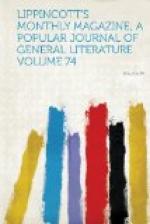The grace and dignity of his appearance, together with the resignation and mildness of his address, melted all the spectators to tears as they gathered round the fatal Tower prison to witness his death: the chaplain who attended him says his behavior was so humble and resigned that even the executioner burst into tears, and was obliged to use strong cordials to support him in his terrible duty. Lord Kilmarnock himself was deeply impressed by the sight of the block draped in funereal black, the plain coffin placed just beside it, the sawdust that was so disposed as speedily to suck up the bloody traces of the execution, and the sea of faces surrounding the open enclosure kept for this his last earthly ordeal. It was certainly not from fear that he recoiled, but his proud, sensitive, melancholy nature was thrilled through every nerve by this dread publicity, and we cannot wonder that, leaning heavily on the arm of a trusty friend, he should have whispered, almost with his last breath, the simple words, “Home, this is dreadful!”
One who was the lineal descendant of this earl of Kilmarnock, and whose only brother long bore the same blood-stained and laurel-wreathed title, has often told me of the strange link that bridged the chasm of four generations from 1746 to 1829, and bound her recollections to those of a living witness of the scene. She was so young as not to have any distinct impression of other events that happened at the same time, but this lived in her mind because of the importance and solemnity with which her own parents had purposely invested it in her eyes. One day, at Brighton, this little great-great-grand-daughter of the Lord Kilmarnock of 1745 was brought down from the nursery to see an old, more than octogenarian, soldier who had distinguished himself in recent wars, and reached the rank of general. This tottering old man, more than fourscore years of age, took the wee maiden of hardly four upon his knee, and told her in simple words the story she was never to forget—how he had been a tiny boy running to school on the day of the execution of the “rebel lords,” and how, seeing a vast, eager crowd all setting toward the Tower quarter, he was tempted to play truant, and flinging his satchel of books over his shoulder, had pushed his way as far as the great state prison. Then of his frantic efforts to secure a point of vantage whence to see the great death-pageant—of his childish admiration for the handsome, manly form of Lord Kilmarnock, of his enthusiasm when Lord Balmerino, the other victim, had cried in a loud voice, “Long live the king!” and of the fascination he could not resist which led his eyes from the shining axe and the draped block to the auburn locks of the prisoner, and soon after to his bleeding head laid low in the sawdust around the coffin. All this the old veteran told thrillingly, the shadow of a boy’s awed recollection mingling with his Scottish exultation as a compatriot of the victim, and even with a touch of humor as he recalled the domestic scolding which marked the truant’s return.




